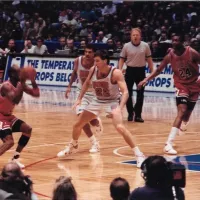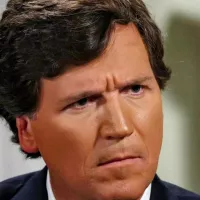College basketball in the U.S. is governed by bodies such as the NCAA, NAIA, USCAA, NJCAA, and NCCAA, which divide institutions into divisions based on scholarship levels. These organizations provide a framework for collegiate competition, though it is possible, albeit rare, for institutions to field teams without any national affiliation. Institutions can have multiple affiliations, except those in the NCAA. Cheyney University, formerly an NCAA member, is one such example of an institution operating without a national affiliation.
1900: Basketball spreads to colleges across the country
By 1900, the game of basketball had spread to colleges across the country.
1904: Hiram College wins Olympic title in demonstration sport
In 1904, at the Summer Olympics where basketball was a demonstration sport, a collegiate championship tournament was held and won by Hiram College.
March 1908: Chicago wins championship series against Penn
In March 1908, the University of Chicago swept a two-game "championship series" against Penn.
1915: College teams were runners-up in the AAU tournament championship
In 1915, College teams were runners-up in the Amateur Athletic Union's (AAU) U.S. national championship tournament.
1916: Utah wins the AAU tournament championship
In 1916, Utah won the Amateur Athletic Union's (AAU) U.S. national championship tournament.
1917: College teams were runners-up in the AAU tournament championship
In 1917, College teams were runners-up in the Amateur Athletic Union's (AAU) U.S. national championship tournament.
1920: NYU wins the AAU tournament championship
In 1920, NYU won the Amateur Athletic Union's (AAU) U.S. national championship tournament.
1921: College teams were runners-up in the AAU tournament championship
In 1921, College teams were runners-up in the Amateur Athletic Union's (AAU) U.S. national championship tournament.
March 1922: First stand-alone post-season tournament
In March 1922, the first stand-alone post-season tournament exclusively for college teams, the 1922 National Intercollegiate Basketball Tournament, was held in Indianapolis, and was won by Wabash College.
1924: Butler wins the AAU tournament championship
In 1924, Butler won the Amateur Athletic Union's (AAU) U.S. national championship tournament.
1925: Washburn wins the AAU tournament championship
In 1925, Washburn won the Amateur Athletic Union's (AAU) U.S. national championship tournament.
1932: College teams were runners-up in the AAU tournament championship
In 1932, College teams were runners-up in the Amateur Athletic Union's (AAU) U.S. national championship tournament.
1934: College teams were runners-up in the AAU tournament championship
In 1934, College teams were runners-up in the Amateur Athletic Union's (AAU) U.S. national championship tournament.
1937: Inauguration of the NAIA Men's Basketball National Championship
In 1937, James Naismith established the NAIA Men's Basketball National Championship to crown a national champion for smaller colleges and universities.
1937: NAIA touts regularly occurring national collegiate championship
In 1937, the NAIA was the first organization to tout a regularly occurring national collegiate championship.
1937: Creation of the NAIB
In 1937, the NAIB was created for smaller colleges after the NIT program only served larger colleges and universities.
1938: First NIT tournament championship game
In the spring of 1938, Temple defeated Colorado in the first NIT tournament championship game, 60–36, held in New York's Madison Square Garden.
1939: Inauguration of the NCAA tournament
In 1939, the National Collegiate Athletic Association (NCAA) implemented its own national tournament.
1944: Cancellation of NAIA Men's Basketball National Championship
The NAIA Men's Basketball National Championship was not held in 1944.
1949: CCNY Beavers men's basketball team double win
Following a double win by the 1949–50 CCNY Beavers men's basketball team (when the NIT comprised 12 and the NCAA 8 teams)
1950: NCAA rules against teams competing in both NIT and NCAA tournaments
In 1950, the NCAA ruled that no team could compete in both the NIT and NCAA tournaments, effectively indicating that a team eligible for the NCAA tournament should play in it.
1951: 1951 scandals based in New York City
In 1951, scandals based in New York City helped the NCAA tournament become more prestigious.
1960: NCAA tournament overtakes NIT in prestige
By 1960, the NCAA tournament had overtaken the NIT in prestige.
1975: NCAA tournament expands to 32 teams
In 1975, the NCAA tournament expanded its field of teams from 25 to 32.
1980: NCAA tournament expands to 48 teams
In 1980, the NCAA tournament expanded its field of teams to 48.
1981: Introduction of Possession Arrow in NCAA Basketball
Since 1981, the NCAA has used a possession arrow to dictate which team possesses the ball after a held ball situation, with the arrow switching directions after each use. This replaced jump balls, except at the start of overtime periods.
1985: NCAA tournament expands to 64 teams
In 1985, the NCAA tournament expanded to 64 teams.
1992: NAIA Sponsors Division II Championship
From 1992 to 2020, the NAIA sponsored a Division II championship, similar to the NCAA Division I and II.
1994: NAIA National Tournament Relocates to Tulsa, Oklahoma
From 1994 to 2001 the NAIA National Tournament was held in Tulsa, Oklahoma.
1999: NAIA National Tournament Relocates from Kansas City
From 1937 to 1999 the NAIA National Tournament was held in Municipal then Kemper Arena in Kansas City.
2001: NAIA National Tournament Relocates from Tulsa, Oklahoma
In 2001 the NAIA National Tournament was held for the last time in Tulsa, Oklahoma.
2002: NAIA National Tournament Relocates to Kansas City
Since 2002 the NAIA National Tournament has been played in Municipal Auditorium in Kansas City, Missouri.
2005: NBA Implements New Dress Code
In 2005, the NBA introduced a new dress code rule, requiring players to wear business casual attire whenever they are engaged in team or league business. This includes a dress shirt or sweater, dress slacks, khaki pants, or dress jeans, and appropriate shoes and socks.
May 2007: NCAA Rules Committee Votes to Extend Three-Point Line
In May 2007, the NCAA Rules Committee voted to extend the three-point line by one foot, from 19 feet 9 inches to 20 feet 9 inches.
2008: Three-Point Line Extended for NCAA Men's Basketball
In the 2008-09 season, the three-point line was extended for NCAA men's basketball to 20 feet 9 inches, following the May 2007 vote.
2011: NCAA tournament expands to 68 teams
In 2011, the NCAA tournament expanded to 68 teams.
2011: Restructuring of NCAA tournament rounds
In 2011, with the NCAA field expanded to 68 teams, the last 8 teams play for four spots making the field into 64, which is called the first round. The former first round is now called the second round.
2011: Three-Point Line Extended for NCAA Women's Basketball
In the 2011-12 season, the three-point line was extended for NCAA women's basketball to 20 feet 9 inches, following the May 2007 vote.
2013: Addition of 10-Second Halfcourt Rule to NCAA Women's Basketball
In the 2013-14 season, a new rule was introduced to NCAA women's basketball, requiring teams to advance the ball past the halfcourt line within 10 seconds, mirroring a similar rule already in place for men's basketball, NBA and WNBA.
2015: Restrictions on NCAA Men's Coaches Calling Timeouts
From the 2015–16 season, NCAA men's coaches were banned from calling timeouts from the bench while the ball is live at any time in the game.
2015: NCAA Men's Basketball Shot Clock Change
Prior to the 2015-16 season, NCAA men's basketball used a 35-second shot clock.
2015: Penalty Rules Change for NCAA Women's Basketball
Since the 2015–16 season, the fifth team foul in a quarter places the team in penalty in NCAA women's basketball. For every foul starting with the fifth, whether shooting or non-shooting, the opposing team receives two free throws.
2016: Re-Structuring of NCAA tournament rounds
In 2016, round numbers changed again in the NCAA tournament, with the first four games containing the last 8 teams now referred to as the first four.
2017: NBA Relaxed Uniform Rules
Since the 2017–18 season, the NBA only requires that road teams wear colors that contrast sufficiently with the home team's choice, meaning that "color on color" games are now possible. This is for regular season play only; home teams always wear white during the playoffs.
2018: NCAA Men's Coaches Ban on Calling Timeouts Still in Effect
Through the 2018–19 season, NCAA men's coaches were banned from calling timeouts from the bench while the ball is live at any time in the game.
2019: Limited Return of Timeouts for NCAA Men's Coaches
From 2019 to 2020, NCAA men's coaches are again allowed to call timeouts from the bench, but only during the last 2 minutes of any period (half or overtime).
2019: NCAA Adopts FIBA Three-Point Arc for Division I Men's Play
In the 2019-20 season, the NCAA adopted the current FIBA three-point arc for Division I men's play, measuring 6.75 m (22 ft 1+1⁄2 in) at the top of the circle and 6.6 m (21 ft 8 in) at the corners and baseline.
2019: NAIA Women's Basketball Championship Split
Through the 2019–20 season there was also an NAIA Women's Basketball Championship, which was also split into Divisions I and II.
2020: NAIA Consolidates to a Single Division for Basketball
From 2020 to 2021, the NAIA will adopt a single-division format for basketball, with the men's and women's tournaments featuring 64 teams each.
2020: Limited Return of Timeouts for NCAA Men's Coaches Continues
In 2020, NCAA men's coaches are allowed to call timeouts from the bench during the last 2 minutes of any period (half or overtime). Players have not been subject to this restriction.
2020: Cancellation of NCAA tournament due to COVID-19
In 2020, the NCAA tournament was canceled for the first time in its history due to fears of the COVID-19 pandemic.
2020: Divisions II and III Follow Suit with FIBA Three-Point Arc
In the 2020-21 season, NCAA Divisions II and III followed Division I in adopting the FIBA three-point arc for men's play, with the women's arc remaining the previous college men's arc. The FIBA arc was to be used on an experimental basis in the 2020 Women's National Invitation Tournament and Women's Basketball Invitational (which ultimately were not held).
2020: Cancellation of NAIA Men's Basketball National Championship
The NAIA Men's Basketball National Championship was not held in 2020.
2021: NCAA Men's Basketball Game Structure Change
In 2021, NCAA men's basketball games transitioned to two 20-minute halves, aligning with the structure used in prior seasons. The shot clock for both men's and women's teams remained at 30 seconds.
2021: NAIA Single-Division Format for Basketball
In 2021, the NAIA adopted a single-division format for basketball, with the men's and women's tournaments featuring 64 teams each. The first two rounds are held at 16 regional sites.
2021: Uncertainty and NCAA waivers after tournament cancellation
In 2021, the cancellation of the NCAA tournament due to the COVID-19 pandemic led to uncertainty, with the NCAA considering granting waivers to winter sports student athletes for regained eligibility.
2023: WAC tournament seeding based on strength ranking
In 2023, the Western Athletic Conference (WAC) men's and women's tournaments used a formulaic ranking of the strength of the qualifiers, including their performances against non-conference opponents, to determine seeding.
July 1, 2024: Big Ten admits four new members
On July 1, 2024, the Big Ten Conference admitted four new members, all of which are located in the Pacific Time Zone.
August 2024: ACC admits new members
In August 2024, the Atlantic Coast Conference (ACC) admitted two new members located in California and one new member located in Texas.
2024: Chicago State joins the Northeast Conference
In 2024, Chicago State, the most recent independent basketball team in Division I of the NCAA, joined the Northeast Conference after competing as an independent for two seasons.
2024: WAC tournament seeding based on strength ranking
In 2024, the Western Athletic Conference (WAC) men's and women's tournaments used a formulaic ranking of the strength of the qualifiers, including their performances against non-conference opponents, to determine seeding.
2025: Cheyney fields a team with no national affiliation
As of 2025, Cheyney, a former NCAA member, fields a basketball team with no national affiliation.
2025: West Coast Conference membership composition
As of 2025, all full members of the West Coast Conference are Christian colleges and universities located in the Pacific Time Zone.
2025: WAC tournament seeding reverts to conference standings
Starting in 2025, the WAC returned to seeding the tournament based on the conference standings, and the formulaic ranking became part of the conference's tiebreaker procedure.
2025: Transitioning teams and NCAA tournament eligibility
Under rules revised in 2025, the transition period from Division II to Division I generally takes three years and may be longer, if the team is coming from a different affiliation. Teams in transition to Division I are not eligible to participate in the NCAA tournament.
Mentioned in this timeline

Basketball is a team sport played on a rectangular court...
California is a U S state on the Pacific Coast...
Arizona is a landlocked state in the Southwestern U S...

James Naismith was a Canadian-American physical educator physician and sports...

Seattle is the most populous city in Washington state and...
North Carolina is a Southeastern U S state the th-largest...
Trending
6 months ago KeyBank Foundation Backs Affordable, Sustainable Housing and Healthy Homes Initiative.

5 months ago Bianca Censori's Past Modeling, Raunchy PDA with Kanye, and Future Plans Spark Debate.

1 month ago Alex Bregman Enters Free Agency; Red Sox Interested, Projected $160M Deal?

Keith Richards is a renowned English musician songwriter singer and record producer best known as a founding member guitarist and...

26 days ago SpaceX Launches Starlink 6-79 Mission from Cape Canaveral, Continuing Satellite Deployments

2 months ago Jillian Michaels Praises Charlie Kirk's Influence on Her Son, Citing Positive Impact.
Popular

Candace Owens is an American conservative political commentator and author...

Ilhan Omar is an American politician currently serving as the...

XXXTentacion born Jahseh Dwayne Ricardo Onfroy was a controversial yet...

Tucker Carlson is an American conservative political commentator known for...

Charles James Charlie Kirk was a prominent American right-wing political...

Kashyap Pramod Patel is an American lawyer who became the...
